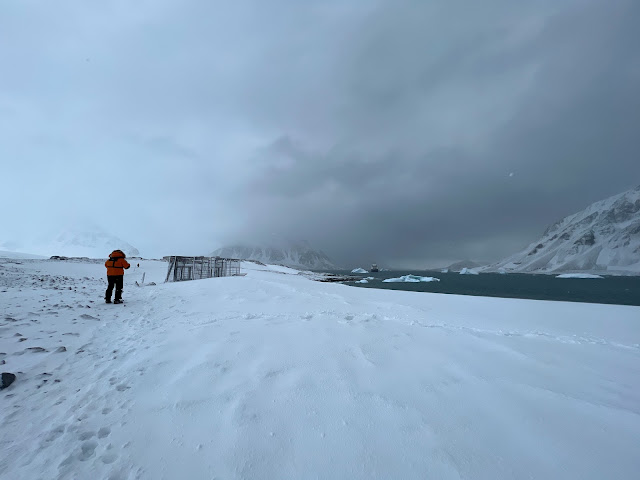 |
| Stonington Island |
Images of the explorations of Charcot and de Gerlache and other inspiring explorers continue to unfold in front of my eyes (in my mind) as we navigate a path south along the Peninsula and then westward. The stories of challenge and hardships, of excitement and deprivation make the scenes come alive.
 |
| Launching the zodiacs for our first landing |
 |
A slow climb through soft snow and rocks
|
In the early hours this morning we arrived at Stonington Island where the plan was to go ashore to visit scientific research bases one established by the USA and the other by the British . We disembarked the zodiacs onto ice-covered rocks (I was quaking in my boots but I made it ashore) and then we ploughed our way up the hill to check out the huts. I only floundered once when my foot went into a sneaky rock cavern hidden by snow. Incidentally it was here that the first two woman over-wintered in Antarctica - this was in the late 1940s. There had been a fair bit of recent snow so the going was a bit slow and it continued to snow while we were there which added an extra little challenge but it was rather an adventure and very beautiful. Of course it was cold but our parkas kept us toasty - mostly.
 |
| The huge glacier in the background calved a number of times while we were on the island. |
'They' said that the island is relatively flat – it is not! But it is absolutely spectacular. On the Island, which is located in the NE part of Marguerite Bay along Graham Land (the Peninsula), two scientific bases remain standing. The first base was established during the US Antarctic Service expedition led by Richard Byrd 1939-41. Later a British base was built close by. It was from here that many explorers set off on dog sledges and managed to map a significant portion of the Antarctic Peninsula. As a matter of interest, the island was named after Stonington, Connecticut, home port of the sloop Hero in which Captain Nathaniel Palmer sighted the Antarctic continent in 1820. That was a time of intensive exploration. In January that same year, a Russian expedition led by Fabian Gottlieb von Bellingshausen and Mikhail Lazarev became the first explorers to see and officially 'discover' the land of the continent of Antarctica. Many others were also exploring this exciting and unknown southernmost continent. Heady days! It's interesting to me that this massive continent which with its islands and ice shelves, is twice the size of Australia and yet remains in name the counterbalance to the Arctic. The name 'Arctic’ comes from the Greek word ‘arktos’, meaning ‘bear’. The northern polar region is the sacred land of the polar bear, one of the largest land predators on the planet. And this relates to Antarctica how?? Well no bears for a start and .....
 |
| This was the British station |
 |
| Inside it looked just like what it was - abandoned |
 |
| In front of the British Base E. It was a mighty day! |
 |
| The US station |
 |
| The remains of dog 'kennels' we think |
 |
| Lindsay climbed the snow-covered rocks to the wee summit. Hooray! |
 |
| The scenes was stark and ethereal at the same time |
 |
| Time to head back to the mothership in very icy conditions |
We were welcomed back on board with cups of hot tea - mine was ginger and honey made fresh. Delicious. It was a great first landing for this expedition.
 |
| We boarded and disembarked the zodiacs via this platform and gangway |
Back on board we started heading for Charcot Island and should get there in the morning.


















No comments:
Post a Comment